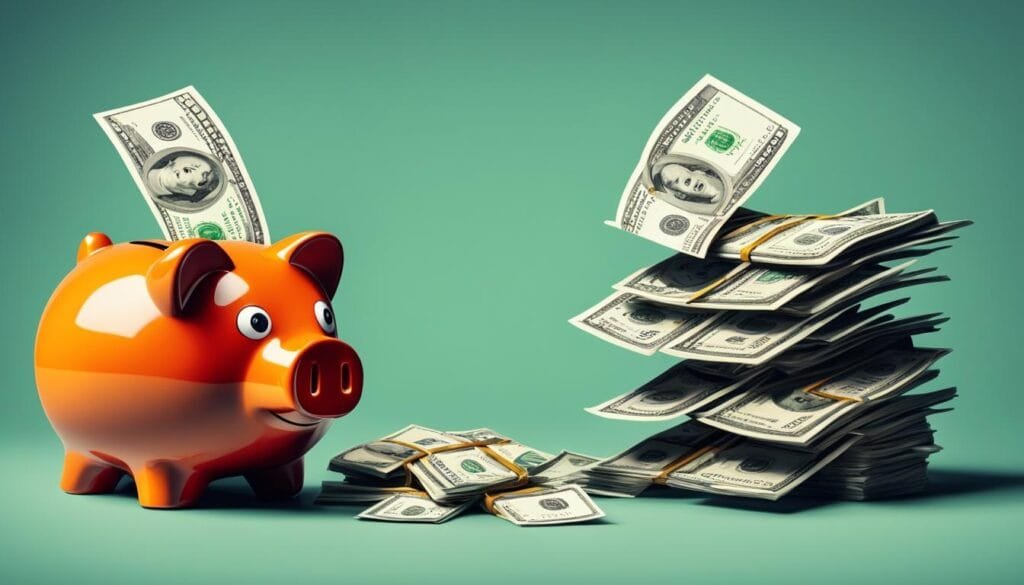Impulse buying is a common behavior that can lead to unplanned purchases and impulsive decision-making. Understanding the psychology behind impulse buying can help individuals make wiser financial decisions and gain control over their spending habits. By examining the 7 phases of impulse purchases and the psychological factors that drive impulsive buying behavior, we can shed light on the consumer decision-making process and the triggers that influence impulsive buying stages.
Impulse buying is not solely driven by the desire to acquire a product; it is influenced by a range of psychological factors. Emotions play a significant role, as individuals may make impulsive purchases to seek emotional comfort or reward themselves. Additionally, external factors such as peer pressure and marketing tactics can trigger impulsive consumer behavior.
The 7 phases of the impulse purchase cycle are crucial in understanding the decision-making process of impulsive buyers. From the initial trigger that sparks the desire to buy to the final moment of satisfaction after the purchase, each stage plays a role in the impulsive buying journey. Psychological factors like social proof, scarcity, and the pleasure of ownership all come into play during these phases.
Impulse buying research has shown that consumers often succumb to impulse purchases due to a combination of emotional factors, cognitive biases, and situational influences. By examining these motivations, we can gain insight into the psychology of impulse buying and learn how to effectively manage this behavior.
Key Takeaways:
- The 7 phases of impulse purchases provide insight into the decision-making process of impulsive buyers.
- Impulse buying is driven by psychological factors such as emotions, cognitive biases, and situational influences.
- Understanding the triggers and motivations behind impulse buying can help individuals make wiser financial decisions.
- Managing impulse buying behavior involves strategies like budgeting, delayed gratification, and shopping with a plan.
- Recognizing and managing emotions, past experiences with money, and the love of shopping can play a crucial role in curbing impulse buying tendencies.
What Is Impulse Buying?
Impulse buying is the act of making unplanned purchases without prior intention or consideration. It encompasses a wide range of buying behaviors, from spontaneous purchases of small items like candy bars to impulsive splurges on larger items like cars. What distinguishes impulse buying is the lack of premeditation or careful thought that typically goes into the shopping process.
Emotions play a significant role in driving impulse buying behavior. Individuals may make impulsive purchases as a way to reward themselves, seek immediate gratification, or alleviate emotional distress. For example, buying a new outfit may provide a temporary mood boost or a sense of excitement. Additionally, past experiences with money management can shape an individual’s propensity for impulse buying. Previous habits and attitudes towards money can influence the level of self-control when faced with tempting buying opportunities.
Factors that Trigger Impulse Buying
There are several factors that can trigger impulse buying:
- Good deals: The perception of a discount or sale can create a sense of urgency and FOMO (fear of missing out), encouraging individuals to make impulsive purchases to take advantage of the perceived bargain.
- Emotions: Positive emotions like excitement and happiness, as well as negative emotions like stress, sadness, or boredom, can drive impulse buying. Retail therapy, for instance, becomes a coping mechanism for emotional distress.
- The love of shopping: Some individuals simply enjoy the act of shopping itself, finding pleasure in browsing and discovering new items. This enjoyment can lead to impulsive purchases, even when there is no immediate need.
Impulse buying can be compared to a rollercoaster ride, with emotions, desires, and external influences taking consumers on an unplanned journey through the aisles of stores and online shopping carts.
Understanding the nature of impulse buying is essential for both consumers and businesses. Consumers can take steps to manage their impulse buying tendencies and avoid unnecessary spending, while businesses can leverage impulse buying triggers to optimize their marketing strategies and encourage unplanned purchases.
Why Do We Keep Impulse Buying?
In the world of consumer behavior, impulse buying is a fascinating phenomenon. Despite our best intentions and financial goals, many of us find ourselves succumbing to the allure of an unplanned purchase. It’s a behavior that is driven by a combination of factors, including emotions, past experiences with money, the promise of a good deal, and even our love of shopping itself.
Emotions play a significant role in fueling impulse buying. Shopping can provide a temporary escape or a means of comfort during times of stress or emotional distress. We may seek solace in the act of making a purchase, even if it’s just a temporary high. This emotional aspect of impulse buying is often referred to as “emotional purchasing,” as it is driven by our feelings rather than logical decision-making.
Past experiences with money also shape our impulse buying behavior. Our previous encounters with financial successes or failures can influence how we perceive and approach purchases. If we have had positive experiences with money, we may be more inclined to indulge in impulsive buys. Conversely, if we have faced financial hardships or struggles, we may be more cautious and mindful of our spending habits.
Another trigger for impulse buying is the lure of a good deal. We all love the feeling of getting a bargain or a discount. The perception that we are saving money can override our rational decision-making and lead us to make impulsive purchases. Marketers and retailers capitalize on this by offering limited-time offers, flash sales, and promotional discounts to entice us into making unplanned purchases.
Lastly, the sheer love of shopping itself can be a trigger for impulse buying. Some people find joy and fulfillment in the act of browsing through stores, discovering new items, and indulging in the process of acquiring things. This inherent enjoyment of the shopping experience can often override practicality and contribute to impulsive buying behavior.
To effectively manage impulse buying behavior, it is crucial to recognize and understand these triggers. By being aware of our emotions, past experiences with money, and the allure of good deals, we can take steps to curb impulsive purchases and make more mindful financial decisions.

How to Stop Impulse Buying
Impulse buying can often lead to unnecessary spending and financial stress. However, with the right strategies in place, it is possible to curb impulsive purchasing habits and make more mindful decisions. Here are some tips to help you stop impulse buying:
- Create and Stick to a Budget: Establishing a budget allows you to prioritize your spending and avoid impulsive purchases. Make a list of your essential expenses and allocate a specific amount for discretionary spending. By tracking your expenses and adhering to your budget, you can prevent unnecessary impulse buys.
- Practice Delayed Gratification: When you feel the urge to make an impulse purchase, try delaying it. Wait for a day or longer before making the decision. This delay can help you assess whether the purchase is essential or just a fleeting desire. Often, the urge to buy impulsively fades with time, leading to more thoughtful spending choices.
- Shop with a Plan: Before heading to the store or browsing online, create a shopping list based on your needs. Stick to the list and avoid deviating from it. Having a plan and specific items to purchase can prevent impulse buying. Remember to focus on your needs rather than wants.
- Avoid Emotional Shopping: Emotional states can significantly influence impulse buying behavior. High-stress levels or negative emotions may lead to retail therapy and impulsive purchases. Be aware of your emotions when shopping and avoid making decisions when you are feeling vulnerable. Find alternative ways to manage your emotions, such as exercising, talking to a friend, or engaging in a hobby.
By implementing these strategies, you can develop healthier spending habits and regain control over your finances. Remember, practicing discipline and mindfulness in your purchasing decisions is key to avoiding impulse buying.

Pros and Cons of Different Anti-Impulse Buying Strategies
| Strategy | Pros | Cons |
|---|---|---|
| Budgeting |
|
|
| Delayed Gratification |
|
|
| Shopping with a Plan |
|
|
| Avoiding Emotional Shopping |
|
|
The Role of Feelings in Impulse Buying Behavior
Emotions play a crucial role in impulse buying behavior. When it comes to making unplanned purchases, consumers’ personal finances are greatly influenced by their emotions. We often seek emotional comfort or rewards through impulsive purchases, driven by a range of feelings and desires.
Marketers are well aware of the link between emotions and impulse buying, and they leverage this understanding to drive sales. They employ strategies such as limited-time offers and enticing sales pitches to tap into consumers’ emotional vulnerabilities and trigger impulsive buying decisions.
Furthermore, our past experiences with money and emotions shape our impulsive buying behavior. For example, a person who has used shopping as a means of coping with stress or seeking pleasure in the past is more likely to succumb to impulsive purchases. Understanding these emotional factors and triggers can help individuals gain better control over their spending habits.
To illustrate the emotional factors in impulse buying, let’s look at some consumer buying stories:
“I was having a rough day at work, feeling overwhelmed and stressed. During my lunch break, I walked into a nearby store and saw a beautiful dress on sale. I immediately felt a rush of excitement and decided to buy it as a way to reward myself and lift my spirits.”
“I had been saving up for a vacation but came across a limited-time offer for a discounted flight ticket. Even though it wasn’t part of my original plan, I couldn’t resist the urge to seize the opportunity. The thought of missing out on such a great deal fueled my impulsive purchase.”
It is crucial for individuals to be aware of the emotional factors at play when engaging in impulsive buying. By understanding these influences, we can make more informed decisions and develop strategies to manage our emotions, ensuring they don’t lead us astray.
Next, we’ll explore effective techniques to stop impulse buying, including budgeting, delayed gratification, shopping with a plan, and avoiding emotional triggers.

How Does Free Shipping Thresholds Impact Impulse Purchases in Shopping Psychology?
Many consumers are influenced by the impact of free shipping threshold when making impulse purchases. Knowing that they can avoid a shipping fee by spending a little more can often push them to add additional items to their cart in order to reach the free shipping threshold, leading to increased sales for retailers.
Conclusion
Impulse buying is a common behavior that can have significant financial consequences if not managed effectively. By understanding the 7 phases of impulse purchases and the psychological factors that drive impulsive buying behavior, individuals can make informed decisions and avoid unnecessary spending. Strategies such as budgeting, delaying gratification, and shopping with a plan can help individuals overcome impulsive buying tendencies. Recognizing and managing emotions and past experiences with money can also play a crucial role in curbing impulse buying behavior. With these strategies in place, individuals can become more mindful consumers and protect their financial well-being.
Managing impulse buying behavior starts with understanding the decision-making process behind it. From the initial triggers to the final purchase, each phase plays a role in the overall cycle. By identifying the triggers and emotional factors that lead to impulsive purchases, individuals can develop strategies to prevent or redirect their impulsive urges.
Impulse buying psychology is complex and influenced by a variety of factors such as emotions, past experiences, and marketing tactics. By recognizing and understanding these psychological drivers, individuals can gain better control over their impulsive buying behavior. This can ultimately lead to more mindful, intentional, and financially responsible purchasing decisions.
FAQ
What are the 7 phases of impulse purchases?
The 7 phases of impulse purchases are crucial in understanding the decision-making process and the factors that drive impulsive buying behavior.
What is impulse buying?
Impulse buying refers to any purchase made without prior planning.
Why do we keep impulse buying?
There are several reasons why individuals continue to engage in impulse buying, such as emotional triggers, past experiences with money management, the perception of a good deal, and the enjoyment of the shopping experience itself.
How can I stop impulse buying?
Strategies to stop impulse buying include creating and sticking to a budget, delaying gratification, shopping with a plan, avoiding emotional shopping, and seeking accountability.
What role do feelings play in impulse buying behavior?
Emotions play a crucial role in impulse buying behavior, as consumers may seek emotional comfort or rewards through impulsive purchases. Understanding the emotional factors and triggers involved can help individuals gain better control over their spending habits.
How can I manage impulse buying behavior?
By understanding the 7 phases of impulse purchases, recognizing emotional triggers, utilizing strategies like budgeting and delayed gratification, and being mindful of past experiences with money, individuals can effectively manage impulse buying behavior and protect their financial well-being.

